Pitahaya/dragon fruit growers come together to learn from UCCE research and each other
At Wallace Ranch in Bonsall, Ramiro Lobo (right) demonstrates how to control pitahaya/dragon fruit leaves as they grow. All photos by Saoimanu Sope.
Once you know what a dragon fruit looks like, you'll never forget it. The bright red, sometimes yellow or purple, scaly skin gives a dramatic appearance. One that will surely leave an impression. The flesh ranges from white to deep pink and the flavor is often described as having hints of kiwi, watermelon or pear.
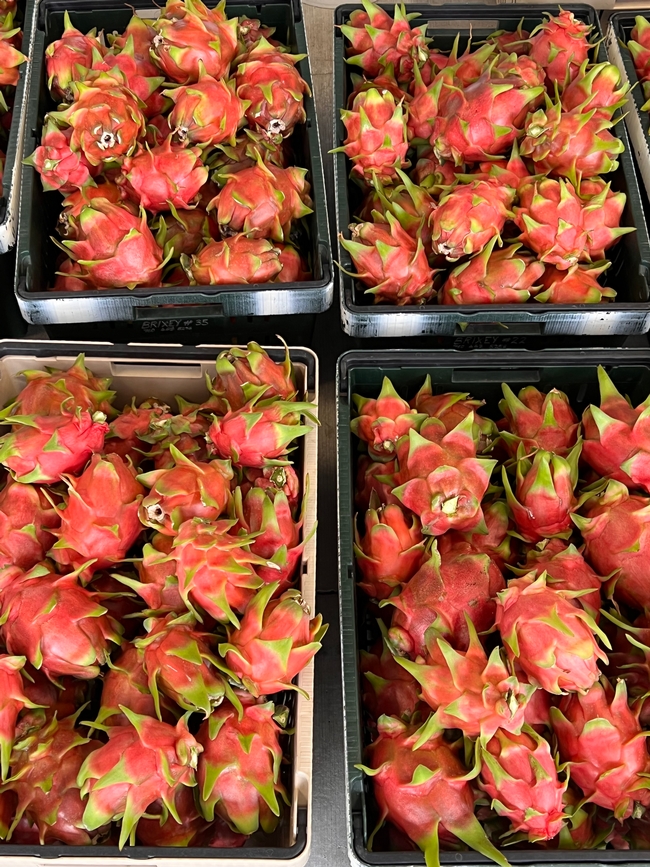
Dragon Delights Farm starts harvesting early in the morning and fills several boxes with pitahaya/dragon fruit.
Since 2007, the Pitahaya/Dragon Fruit Production Tour has brought together dragon fruit producers of all skill levels and backgrounds. After a two-year hiatus due to the pandemic, registrations for the 2022 tour filled up in less than 24 hours.
A group of 60 attendees gathered on September 8 at the Wallace Ranch Dragon Fruit Farm in Bonsall to learn about the latest research on growing this special drought-tolerant crop. Ramiro Lobo, an Agricultural Economics and Small Farms Advisor for UC Cooperative Extension in San Diego County, introduced dragon fruit growers and other UC scientists.
"I can't remember a year where this event hasn't sold out. So the need and the demand is there," said Eyal Givon, long-time attendee and dragon fruit grower.
The tour not only demonstrates how to grow the fruit, but also allows participants to access plant material for varieties not available elsewhere.
“We distributed about 50,000 cuttings through our festival and some varieties were unique to us because we introduced them to the United States,” Lobo said.
While at Wallace Ranch, attendees heard from farm owner Neva Day about the farming practices that have shaped her success today. Day has been growing organic dragon fruit since 2013 and has over 5,000 ground plants and over 20 varieties.
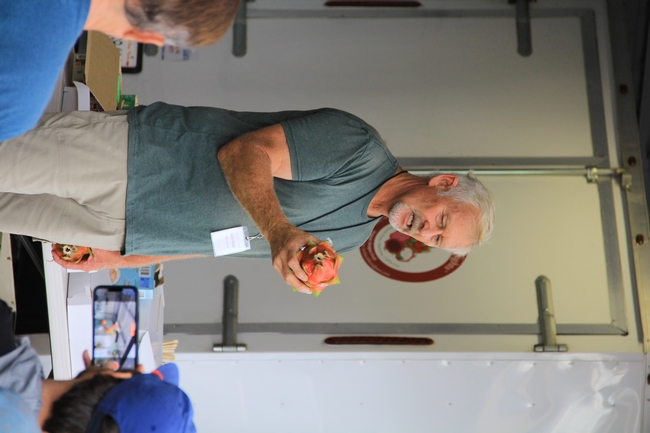
Kevin Brixey, owner of Dragon Delights Farm, shares his experience as a grower.
Eric Middleton, UCCE's Integrated Pest Management Area Advisor for San Diego County, spoke about managing insects and pests that growers are likely to encounter, such as Argentine ants.According to Middleton, Pecan Sandies are a balanced source of fat, protein, and sugar, making them an excellent bait for sugar-loving insects.
Participants eventually made their way to Dragon Delights Farm located in Ramona. Farm owner Kevin Brixey has been growing organic dragon fruit for six years.
Brixey was hosting this year's tour participants, he was one of them.
"I attended the Pitahaya Festival in 2014 and that's when I realized that dragon fruit was something I could grow. There was a lot of good information shared and a connection with d other producers, so it was a major stepping stone for me,” he says.
Unlike traditional dragon fruit growers, Brixey uses shade to grow his dragon fruit after learning the method from another grower.
“I was impressed. I liked how the fruit did in the shade and now I use it as a management tool,” Brixey explained. In the inland valleys, shade can protect the fruit from intense sunlight and protect it from unwanted fruit-eating guests, such as birds.
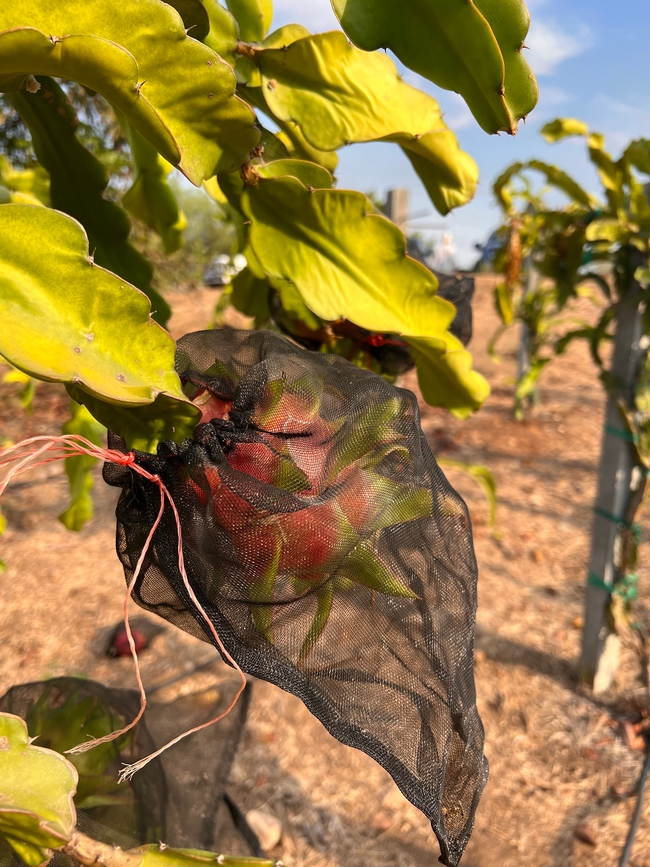
To protect the fruits from insects and birds, the pitahayas/dragon fruits are covered with a mesh bag.
At the offices of the San Diego County Farm Bureau, attendees learned about the history of growing dragon fruit in California, food safety, pest management, best production practices and more.
Presenters included experts such as Paul Erickson of Rare Dragon Fruit, Lobo, Middleton, Johanna del Castillo of the Department of Plant Pathology at UC Davis and...
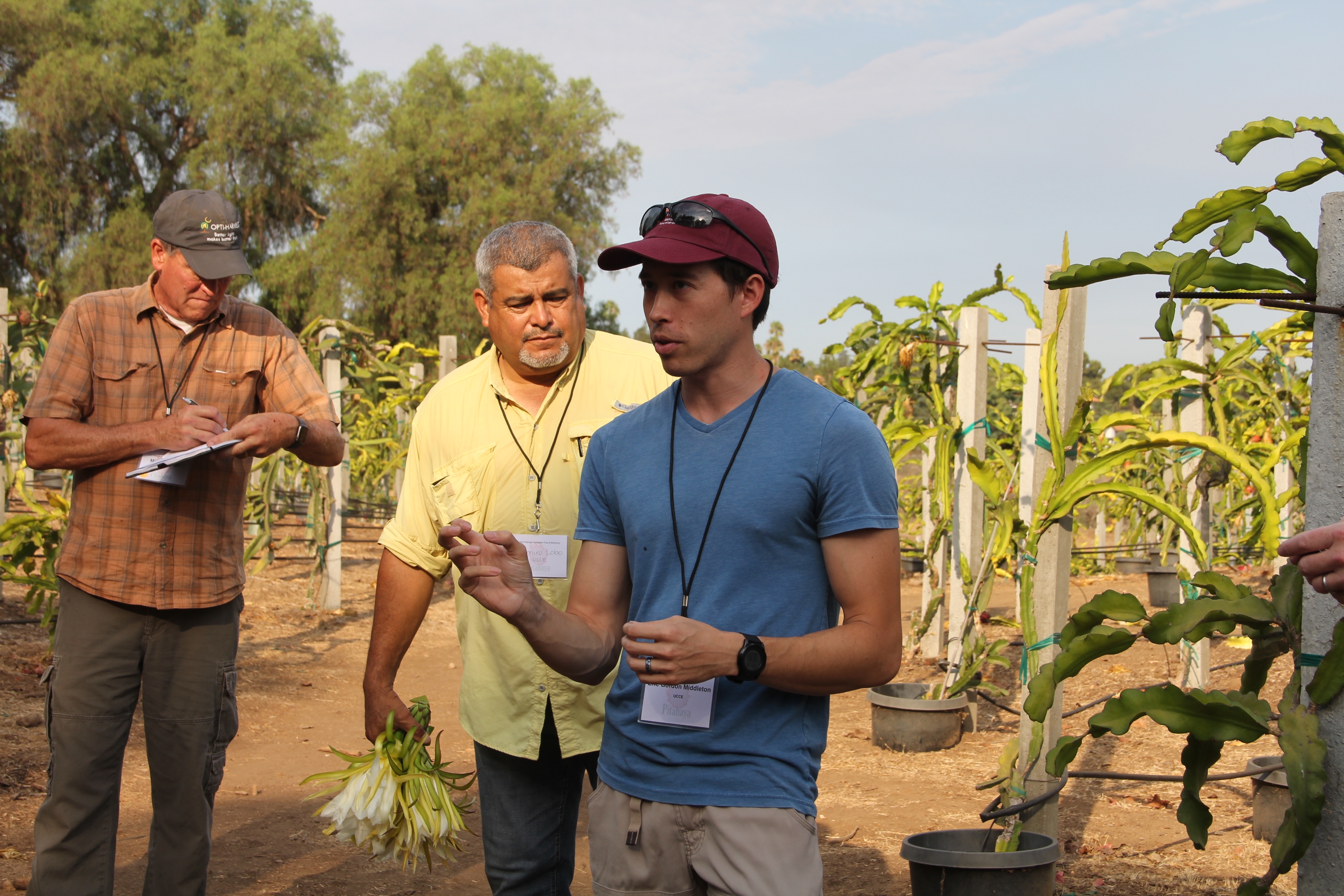
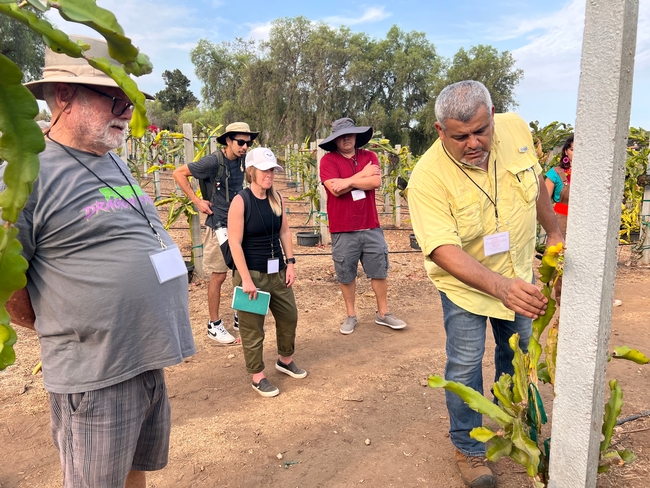
At Wallace Ranch in Bonsall, Ramiro Lobo (right) demonstrates how to control pitahaya/dragon fruit leaves as they grow. All photos by Saoimanu Sope.
Once you know what a dragon fruit looks like, you'll never forget it. The bright red, sometimes yellow or purple, scaly skin gives a dramatic appearance. One that will surely leave an impression. The flesh ranges from white to deep pink and the flavor is often described as having hints of kiwi, watermelon or pear.

Dragon Delights Farm starts harvesting early in the morning and fills several boxes with pitahaya/dragon fruit.
Since 2007, the Pitahaya/Dragon Fruit Production Tour has brought together dragon fruit producers of all skill levels and backgrounds. After a two-year hiatus due to the pandemic, registrations for the 2022 tour filled up in less than 24 hours.
A group of 60 attendees gathered on September 8 at the Wallace Ranch Dragon Fruit Farm in Bonsall to learn about the latest research on growing this special drought-tolerant crop. Ramiro Lobo, an Agricultural Economics and Small Farms Advisor for UC Cooperative Extension in San Diego County, introduced dragon fruit growers and other UC scientists.
"I can't remember a year where this event hasn't sold out. So the need and the demand is there," said Eyal Givon, long-time attendee and dragon fruit grower.
The tour not only demonstrates how to grow the fruit, but also allows participants to access plant material for varieties not available elsewhere.
“We distributed about 50,000 cuttings through our festival and some varieties were unique to us because we introduced them to the United States,” Lobo said.
While at Wallace Ranch, attendees heard from farm owner Neva Day about the farming practices that have shaped her success today. Day has been growing organic dragon fruit since 2013 and has over 5,000 ground plants and over 20 varieties.

Kevin Brixey, owner of Dragon Delights Farm, shares his experience as a grower.
Eric Middleton, UCCE's Integrated Pest Management Area Advisor for San Diego County, spoke about managing insects and pests that growers are likely to encounter, such as Argentine ants.According to Middleton, Pecan Sandies are a balanced source of fat, protein, and sugar, making them an excellent bait for sugar-loving insects.
Participants eventually made their way to Dragon Delights Farm located in Ramona. Farm owner Kevin Brixey has been growing organic dragon fruit for six years.
Brixey was hosting this year's tour participants, he was one of them.
"I attended the Pitahaya Festival in 2014 and that's when I realized that dragon fruit was something I could grow. There was a lot of good information shared and a connection with d other producers, so it was a major stepping stone for me,” he says.
Unlike traditional dragon fruit growers, Brixey uses shade to grow his dragon fruit after learning the method from another grower.
“I was impressed. I liked how the fruit did in the shade and now I use it as a management tool,” Brixey explained. In the inland valleys, shade can protect the fruit from intense sunlight and protect it from unwanted fruit-eating guests, such as birds.

To protect the fruits from insects and birds, the pitahayas/dragon fruits are covered with a mesh bag.
At the offices of the San Diego County Farm Bureau, attendees learned about the history of growing dragon fruit in California, food safety, pest management, best production practices and more.
Presenters included experts such as Paul Erickson of Rare Dragon Fruit, Lobo, Middleton, Johanna del Castillo of the Department of Plant Pathology at UC Davis and...
What's Your Reaction?














![Three of ID's top PR executives quit ad firm Powerhouse [EXCLUSIVE]](https://variety.com/wp-content/uploads/2023/02/ID-PR-Logo.jpg?#)







